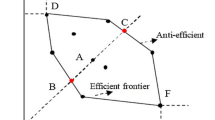Abstract
Ranking efficiency based on data envelopment analysis (DEA) results can be used for grouping decision-making units (DMUs). The resulting group membership can be partly related to the environmental characteristics of DMU, which are not used either as input or output. Utilizing the expert knowledge on super efficiency DEA results, we propose a multinomial Dirichlet regression model, which can be used for the purpose of selection of new projects. A case study is presented in the context of ranking analysis of new information technology commercialization projects. It is expected that our proposed approach can complement the DEA ranking results with environmental factors and at the same time it facilitates the prediction of efficiency of new DMUs with only given environmental characteristics.
Similar content being viewed by others
References
Andersen P and Peterson NC (1993). A procedure for ranking efficient units in data envelopment analysis. Mngt Sci 39: 1261–1264.
Banker RD, Charnes A and Cooper WW (1984). Some models for estimating technical and scale efficiency in data envelopment analysis. Mngt Sci 30: 1078–1092.
Charnes A, Cooper WW and Rhodes E (1978). Measuring the efficiency of decision making units. Eur J Opl Res 2: 429–444.
Dyson RG, Allen R, Camanho AS, Podinovski V, Sarrico CS and Shale EA (2001). Pitfalls and protocols in DEA. Eur J Opl Res 132: 3–17.
Farrell MJ (1957). The measurement of productive efficiency. J R Statist Soc Ser A 120: 253–290.
Førsund F and Sarafoglou N (2002). On the origins of data envelopment analysis. J Product Anal 17: 23–40.
Friedman L and Sinuany-Stern Z (1998). Combining ranking scales and selecting variables in the DEA context: the case of industrial branches. Comput Oper Res 25: 781–791.
Greene WH and Hensher DA (2003). A latent class model for discrete choice analysis: contrast with mixed logit. Transport Res Part B 37: 681–698.
Johnson N and Kotz S (1970). Distributions in Statistics: Continuous Univariate Distributions. Wiley: New York.
SAS Institute (1998). SAS/STAT User's Guide 6.03. SAS Institute: Cary, NC.
Sohn SY (1993). A comparative study of four estimators for analyzing the random event rate of the Poisson process. J Statist Comput Simulat 49: 1–10.
Sohn SY (1996). Empirical Bayesian analysis for traffic intensity: M/M/1 queues with covariates. Queue Syst 22: 383–401.
Sohn SY (1997). Bayesian dynamic forecasting for attribute reliability. Comput Industr Eng 33: 741–744.
Sohn SY (1999). Robust parameter design for integrated circuit fabrication procedure with respect to categorical characteristic. Reliab Eng Syst Safe 66: 253–260.
Sohn SY (2002). Robust design of server capability in M/M/1 queues with both partly random arrival and service rates. Comput Oper Res 29: 433–440.
Sohn SY and Choi H (2005). Random effects logistic regression model for data envelopment analysis with correlated decision making units. J Opl Res Soc, accepted for publication.
Sohn SY and Moon TH (2003). Structural equation model for predicting technology commercialization success index. Technol Forecast Social Change 70: 885–899.
Sohn SY and Yoon KB (2005). Dynamic preventive maintenance scheduling of the modules of fighter aircrafts based on random effects regression model, submitted for publication.
Acknowledgements
This work was supported by the Korea Research Foundation Grant (KRF-2003-041-D00612).
Author information
Authors and Affiliations
Corresponding author
Rights and permissions
About this article
Cite this article
Sohn, S. Random effects logistic regression model for ranking efficiency in data envelopment analysis. J Oper Res Soc 57, 1289–1299 (2006). https://doi.org/10.1057/palgrave.jors.2602117
Received:
Accepted:
Published:
Issue Date:
DOI: https://doi.org/10.1057/palgrave.jors.2602117




